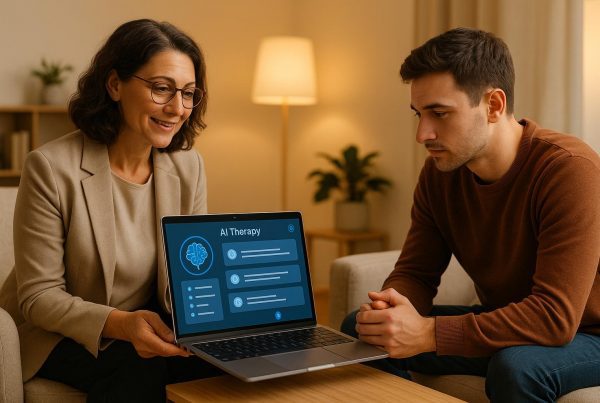Social media can harm your mental health if not used carefully. Setting boundaries helps you stay in control, improve your well-being, and avoid common pitfalls like anxiety, depression, and FOMO (Fear of Missing Out). Here’s what you need to know:
- Why it matters: Overuse is linked to mental health issues such as loneliness, low self-esteem, and poor sleep.
- Signs you need limits: Constant scrolling, prioritizing online interactions over real-life, or feeling stressed when disconnected.
- Benefits of boundaries: Research shows limiting use to 30 minutes a day reduces anxiety and boosts positive emotions.
- How to set boundaries:
- Track and limit screen time using tools like Apple’s Screen Time or Android’s Digital Wellbeing.
- Unfollow accounts that make you feel negative and follow uplifting ones.
- Take regular breaks, turn off notifications, and create phone-free zones (e.g., during meals or before bed).
- Replace scrolling with offline activities like exercise, journaling, or spending time with loved ones.
How Social Media Harms Your Mental Well-Being + The Boundaries to Set! – Terri Cole
How Social Media Affects Your Mental Health
Social media’s influence on mental health can vary widely, depending on how you use it and the type of content you engage with.
Benefits and Drawbacks of Social Media Use
When used thoughtfully, social media can be a powerful tool for connection, especially for people who feel isolated [6][2]. Online communities provide much-needed peer support, coping strategies, and a sense of belonging [4][6]. These platforms also help you maintain relationships across distances, access educational resources on mental wellness, and discover motivational content that promotes healthy habits.
However, this same connectivity can have a darker side. Social media often fosters harmful comparisons and a need for validation [6][3]. Scrolling through highlight reels of others’ accomplishments, vacations, or seemingly perfect lives can leave you feeling inadequate. This can spark envy, anxiety, or a drop in self-esteem [6][2][3].
Another challenge is information overload. Endless scrolling – especially through negative news or "doomscrolling" – can amplify stress and anxiety [4]. Exposure to hostile or misleading content can further harm mental health [6].
Studies highlight the risks of overuse. For example, young adults juggling 7–11 platforms are three times more likely to experience depression and 3.2 times more likely to face anxiety compared to those using just two or fewer platforms [6]. This suggests that spreading your attention across too many platforms may intensify negative effects.
The type of content you consume also plays a critical role. Curating a feed filled with positive and uplifting content can boost your well-being, while exposure to unrealistic standards can have the opposite effect [4]. Essentially, your experience on social media mirrors the choices you make about what to follow and engage with.
Understanding these pros and cons can help you set boundaries when needed.
Warning Signs You Need Social Media Boundaries
Certain behavioral patterns can signal when it’s time to reassess your social media use. For instance, compulsively checking your phone every few minutes, feeling anxious when disconnected, or immediately checking notifications upon waking may indicate unhealthy habits [4][7].
Your offline life can also provide clues. If you find yourself prioritizing scrolling over completing tasks or spending time with loved ones, it might be time to step back [2][3]. Sleep, which is essential for emotional balance, can also suffer when social media use creeps into late-night hours.
Pay attention to your mood before and after using social media. If browsing consistently leaves you feeling anxious, depressed, or dissatisfied, it’s a sign that your current habits might not be supporting your mental health [4]. Physical symptoms like increased stress or irritability when offline are worth noting as well.
Another red flag is relying on likes and comments to feel validated. Similarly, if you experience anxiety about missing out on online events (commonly known as FOMO), it may be time to reevaluate your relationship with social media [2][3].
The good news? Recognizing these signs empowers you to take control. For example, a U.S. study of 230 college students found that limiting social media to 30 minutes a day for two weeks led to higher positive emotions and reduced anxiety, depression, loneliness, and FOMO compared to unrestricted use [5]. Even small adjustments in how you engage with these platforms can make a noticeable difference in your mental well-being.
These observations set the stage for actionable strategies to safeguard your mental health, which will be explored in the next section.
How to Set Social Media Boundaries That Work
Taking charge of your social media habits means setting clear boundaries and sticking to them. These strategies can help you regain control, protect your mental health, and create a healthier relationship with your digital world.
Track and Limit Your Screen Time
Start by keeping tabs on how much time you spend scrolling. Most smartphones have built-in tools like Apple’s Screen Time for iOS or Android’s Digital Wellbeing. These features let you see how long you’re using each app and even set daily limits that lock you out once you’ve hit your cap [4][2].
The benefits of limiting screen time are backed by research. A study involving 230 college students found that cutting social media use to 30 minutes a day for two weeks led to less anxiety, depression, and loneliness. Participants also reported fewer feelings of missing out and more positive emotions – even if they occasionally went over their limit [5].
If you want more detailed insights, third-party apps can provide extra analytics and reminders. The key is to find a system that works for you, giving you a clear picture of your habits while helping you meet your goals. Once you’ve got a handle on your screen time, it’s time to clean up your social media feed.
Clean Up Your Social Media Feed
What you see on your feed can have a big impact on your mood. Take a moment to unfollow accounts that bring negativity into your life. This might mean influencers promoting unrealistic body standards, pages spreading misinformation, or people who thrive on drama [4].
Instead, fill your feed with content that uplifts you. Follow mental health organizations, educational pages, or creators who share encouraging and realistic messages [4][3]. It’s important to regularly review your feed and notice how different posts make you feel. If scrolling leaves you feeling stressed, inadequate, or irritable, it’s time to make more changes. Your feed should add value to your day, not take away from it. Once your feed feels more positive, consider stepping back with scheduled breaks.
Take Regular Breaks from Social Media
Taking intentional breaks from social media can help you reset and reduce dependency. Try setting specific times of day for checking your feeds – like during lunch or after work [4][2].
You could also experiment with "digital detox" periods – whether it’s a few hours, a full day, or an entire weekend without social media. Use this time to focus on offline activities like exercising, reading, or spending quality time with loved ones. These breaks can help break the habit of mindlessly reaching for your phone.
Another simple way to create space is by turning off notifications. Notifications can pull you into apps unnecessarily, so disabling them lets you engage on your own terms. Start small by logging out of social media apps for an hour in the evening, then gradually extend these breaks as you get more comfortable being offline. To make these boundaries even stronger, think about creating phone-free spaces.
Create Phone-Free Times and Spaces
Designating certain times and places as phone-free zones can make a big difference. For example, keep phones off the dining table, out of the bedroom, and away during family time. Use your phone’s "Do Not Disturb" mode to help enforce these rules [4].
One especially important boundary? No phones an hour before bed. The blue light from screens can disrupt your sleep, and late-night scrolling often leads to stress or overstimulation [2]. Try keeping your phone in another room at night and use a traditional alarm clock instead.
Another idea is to have device-free meals, which encourage better conversations and even aid digestion. A shared charging station in a common area can make this easier – everyone parks their devices there during phone-free hours. This visible reminder helps reinforce the habit and keeps everyone accountable.
sbb-itb-d5e73b4
Building a Healthy Balance Between Online and Offline Life
Finding the right balance between your digital life and the real world is key to maintaining a healthy relationship with social media. It’s all about creating a mix that keeps both aspects rewarding and meaningful. Let’s dive into some practical ways to make this happen.
Replace Social Media Time with Offline Activities
Cutting back on social media opens up time for activities that genuinely improve your well-being. For instance, journaling is a fantastic way to process emotions and ease stress. Instead of passively consuming other people’s updates, you’re actively reflecting on your own thoughts and feelings.
Another great option is exercise, which boosts your mood by releasing endorphins. Whether it’s a brisk 20-minute walk around the block or a full workout session, moving your body offers a sense of accomplishment that far outlasts the fleeting satisfaction of scrolling through a feed.
Engaging in creative hobbies – like painting, gardening, or learning an instrument – can bring a sense of relaxation and achievement. These activities not only keep your hands busy but also give your brain a much-needed break from screens. Interestingly, studies suggest that heavy social media use can dull your brain’s ability to enjoy offline activities, but this effect reverses when you spend more time away from the screen [8].
Spending quality time with friends and family is another powerful antidote to the isolation that often accompanies excessive social media use. Face-to-face conversations, shared meals, and group outings provide the kind of deep connection that no online interaction can replicate.
The trick is to experiment with different offline activities and notice how they affect your mood and energy levels. Keeping a simple journal can help you track what works best for you, making it easier to prioritize activities that truly enhance your well-being.
Create a Daily Routine That Includes Both Digital and Offline Time
Once you’ve identified fulfilling offline activities, the next step is to structure your day so it includes a healthy mix of screen time and real-world engagement. The goal isn’t to cut out technology entirely but to use it more intentionally.
Start by scheduling specific times for social media use. For example, you might decide to check your apps during lunch and for 15 minutes after dinner – but avoid aimless scrolling at other times.
To protect your offline time, block out specific periods on your calendar for activities like reading, exercising, or spending time with loved ones. Treat these as non-negotiable appointments to ensure they don’t get pushed aside by digital distractions.
Creating morning and evening routines that are screen-free can also help. In the morning, you might focus on meditation, journaling, or taking a walk before diving into any digital tasks. At night, winding down with a book, stretching, or chatting with family can help you disconnect and improve your sleep [2][3].
You can also use digital tools to set app limits or reminders, making it easier to switch gears when it’s time for offline activities. The aim is to create a rhythm where both online and offline moments feel natural and balanced.
Setting Screen Time Rules for Your Family
Just as individuals benefit from setting boundaries, families thrive when they establish shared digital rules. When everyone agrees on the guidelines, it’s easier to stick to healthy habits. Hold regular family discussions to set these rules together. This could include device-free dinners, screen-free bedrooms, or specific hours when the whole family focuses on offline activities.
Collaborating on these rules ensures everyone feels involved and committed. Kids, in particular, are more likely to follow guidelines they helped create, and they’ll better understand the purpose behind them.
Some practical family rules might include no devices at the dinner table, a screen-free day each week, or limiting screen time to two hours a day outside of work or school. Families who adopt such boundaries often find they communicate better, spend more quality time together, and argue less about devices [3].
As parents, it’s essential to set an example. Kids naturally mimic adult behavior, so if you’re constantly glued to your phone, they’ll think that’s normal. By putting your device away during conversations, pursuing offline hobbies, and respecting screen-free times, you’re showing them what balanced habits look like.
Finally, weekly family check-ins can help you evaluate how the rules are working and make adjustments as needed. These discussions also create a safe space for family members to share any struggles or concerns about social media use. The focus should always be on what you’re gaining – more time for connection, fun, and shared experiences – rather than what you’re giving up.
Using AI Tools to Maintain Social Media Boundaries
AI tools can be a game-changer when it comes to keeping your social media habits in check. These tools go beyond basic strategies by offering personalized support and real-time tracking to tackle the challenges unique to your situation.
Tailored Support for Setting Boundaries
One standout tool is Aidx.ai, a voice-enabled AI coach and therapist designed to help you establish meaningful social media boundaries. It employs evidence-based methods like Cognitive Behavioral Therapy (CBT) and Acceptance and Commitment Therapy (ACT) to address the deeper reasons behind your social media habits.
What makes it unique? Its Adaptive Therapeutic Intelligence (ATI) System™. This system learns your communication style, emotional triggers, and behavior patterns to create a customized approach. For example, if you tend to scroll endlessly when you’re anxious, the AI might guide you through CBT techniques to challenge those thought patterns and suggest alternative activities that align with your values.
The platform’s natural, conversational interface provides real-time coaching for issues like FOMO or compulsive scrolling. Instead of generic advice like "spend less time online", it helps you understand why you’re drawn to social media and develops strategies that fit your motivations.
The voice-enabled design also means you can access support anytime, anywhere – without needing to type or stare at a screen. This makes it convenient and easy to integrate into your daily routine.
Real-Time Tracking and Progress Monitoring
Creating boundaries is one thing; maintaining them is another. Aidx.ai’s tracking features help you see how your efforts are paying off. It monitors key aspects of your well-being, such as stress, anxiety, confidence, and emotional states, giving you a clear picture of how your habits are evolving.
The platform includes a planner and self-monitoring tools that track your progress in real time. For instance, you can set goals to limit time on certain apps or avoid social media first thing in the morning. It even sends reminders through push notifications or email to keep you on track.
If you find yourself struggling, you can instantly engage with the AI for support. The system draws on your past interactions to provide context-aware advice that feels relevant and actionable. This ongoing feedback loop helps you stay motivated and fine-tune your boundaries as needed.
Balancing Privacy with Personalization
When it comes to discussing personal challenges like social media use, privacy is a big concern. Aidx.ai addresses this with a privacy-first approach. It complies with GDPR regulations, encrypts your data, and ensures no human oversight unless absolutely required by law.
For added peace of mind, the platform offers an incognito mode that clears session data after 30 minutes of inactivity. This allows you to explore sensitive topics anonymously, which is especially helpful when dealing with deeper issues related to your social media habits.
Despite these strict privacy measures, the ATI System™ still provides personalized support. As it learns from your interactions, it becomes better at asking the right questions and suggesting strategies that resonate with you. This balance between privacy and personalization ensures you can be open about your struggles without worrying about data security.
Conclusion: The Long-Term Benefits of Social Media Boundaries
Establishing boundaries around social media use isn’t just about cutting down screen time – it’s about prioritizing your mental health, boosting productivity, and nurturing personal growth for the long haul. Research backs this up: people who develop healthy social media habits often see noticeable improvements in multiple areas of their lives.
One of the most impactful benefits lies in mental health. A 2023 U.S. study found that limiting social media use to just 30 minutes a day significantly reduced feelings of anxiety, depression, and loneliness while fostering more positive emotions[5]. These mental health gains only grow stronger with consistent practice. But the ripple effects don’t stop there – these boundaries can also enhance productivity and deepen your relationships.
By stepping away from constant notifications and endless scrolling, you reclaim time and mental energy for more meaningful activities. Whether it’s focusing on creative projects or simply being present with loved ones, the absence of digital distractions allows you to engage more fully. Relationships, in particular, benefit when social media takes a backseat. Without the pull of screens, you can give your full attention to conversations and connect on a deeper level.
To keep these benefits going, it’s crucial to reassess your boundaries regularly. As your life evolves and new platforms emerge, taking a step back every few months to evaluate your habits ensures your boundaries stay relevant and effective[1].
Tools like Aidx.ai can be a valuable ally in maintaining these boundaries. With its Adaptive Therapeutic Intelligence (ATI) System™, Aidx.ai learns and adapts to your shifting patterns, helping you notice when old habits creep back in. It even offers personalized strategies to keep you on track, while its Life Coaching mode provides ongoing support for building better digital discipline.
Over time, these boundaries become second nature. As you enjoy better sleep, reduced stress, and a boost in productivity, you’ll naturally want to maintain these improvements. What starts as a conscious effort gradually transforms into balanced, sustainable habits.
Remember, progress matters more than perfection. It’s normal to slip back into old patterns occasionally. What’s important is having tools and strategies – whether personal or AI-driven – to help you recognize those moments and quickly get back on course.
FAQs
How can I tell if my social media use is harming my mental health?
Paying attention to how social media makes you feel and affects your daily routine is key to understanding its influence on your mental health. Does scrolling leave you feeling anxious, stressed, or not good enough? Are you constantly comparing yourself to others, battling FOMO (fear of missing out), or struggling to put your phone down?
Other red flags include disrupted sleep, falling behind on responsibilities, or feeling overwhelmed by endless notifications. If these patterns sound familiar, it might be time to set some boundaries or take a step back to prioritize your well-being.
How can I reduce my screen time while staying connected with my online community?
Finding a balance between reducing screen time and staying connected is key. One way to start is by setting clear time limits for social media apps or designating specific periods for online activity. This approach allows you to stay engaged without letting screen time take over.
Another strategy is to focus on quality over quantity when it comes to interactions. Spend time having meaningful conversations or participating in smaller, interest-based groups that reflect your values. Lastly, explore offline alternatives – meet up with friends face-to-face or dive into hobbies that bring you joy and satisfaction away from the digital world.
How can Aidx.ai help me set healthy boundaries on social media while improving my mental well-being?
Aidx.ai is designed to help you create healthier boundaries with social media by offering real-time, personalized support that fits your needs. Its Adaptive Therapeutic Intelligence (ATI) system adapts to your communication style and challenges, using proven techniques like CBT (Cognitive Behavioral Therapy), DBT (Dialectical Behavioral Therapy), and NLP (Neuro-Linguistic Programming) to help you manage stress and find balance.
With tools like progress tracking, goal-setting, and smart check-ins, Aidx.ai keeps you on track and accountable. Think of it as your around-the-clock mental wellness companion, supporting you in building better habits and maintaining emotional health in today’s digital age.



